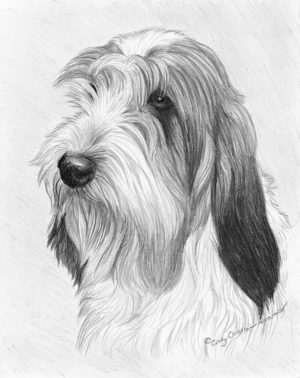
Despite his disastrous Italian wars, Louis XII of France was known as “good king Louis” and the “father of his people.” His reign was remembered as a golden age of peace and repose, and not surprisingly, he was popular among his people. It stands to reason that a good king should have happy dogs, and specifically, a happy breed. Enter the Petit Basset Griffon Vendéen. This canine extrovert love to work, and always seems to be in good spirits, and when several PBGVs were given to King Louis XII, it seems to us all these years later that it must have been a good fit. In Louis’ time, the breed was called Chiens Blancs du Roi, or the King’s White Hounds, and if the PBGV wasn’t enough, Louis kept Grand Basset Griffon Vendéens, as well.
It may be prudent to mention at this point that in Frank Sherman Peer’s book, The hunting field with horse and hound in America: the British Isles and France, mention is made of a particular breed of hounds that originated during the reign of Louis XI: “King Louis XI received from a poor gentleman a certain white dog, called ‘Souliard,’ and it was from this celebrated dog, that the famous race, ever since known as ‘The White Hounds of the King,’ descended. Louis XII continued in the same line, and so on down to the reign of Charles IX, who published a book on hunting, and could not say enough in praise of this race of dogs.”
Based on subsequent remarks in the chapter, our suspicion is that these white hounds were a breed known as the Billy, and not PGBVs. In fact, according to M. le Couteuix and the Baron de Noirmont, at least a dozen different types of scenting hounds existed in France in the hundreds of years prior to the French Revolution, and of these, four were known as “Royal,” meaning they were used exclusively by the King: These dogs included the St. Hubert’s, the King’s White Hounds, the Fawn Hounds of Brittany, and the Grey Hounds of St. Louis.
Interestingly, among the breeds kept by individual noblemen were the Hounds of Bresse, Vendéan Griffons (rough—coated), Gascon Hounds, Normandy Hounds, Hounds of Saintonge, Poitou Hounds, Céris Hounds, and D’Artois Hounds.
Image: Petit Basset Griffon Vendéen by Charlotte Yealey
http://www.charlotteyealey.com

Carol Stuart
Carol Stuart These happy hounds are first and foremost determined hunting dogs. They are only a few generations removed from the hunting packs of Europe where they are kept as hunting pack hounds and not as pets. They have a voice “freely used” and can be very noisy and difficult to train. They have the softness of the hound which becomes offended and withdraws from corrections and the deep determination of the terrier which defies all attempts to be naturally compliant. They should NEVER be left off lead as they go deaf when they decide to go hunting on their own. Most PBGV’s who are killed are killed because they escape or are left off lead and do not or will not respond to your wails to “Come”. The coats can be harsh and easy care and some are thick and cottony and difficult to groom. But all PBGV’s do require grooming. All PBGV’s who are bred should be tested for the genetic disease Primary Open Angle Glaucoma (POAG) which is a problem in the breed. Epilepsy is also an issue and unfortunately there is no genetic test available for PBGV’s. So buyers need to question the breeder about the incidence of both diseases in the breed. PBGV ‘s are an exceptionally cute breed and many fall in love with the look of the breed but also must respect the genetics of a hunting hound with a loud voice and an desire to engage in hunting behaviors. They do very well as pack dogs but not so well as kennel dogs. They are a wonderful breed for those who can adapt to their unique needs and appreciate their hond/terrier qualities.
A wonderfully informed comment, Dr. Stuart, thank you for sharing it here because not all our readers are on Facebook. A few years back, Eukanuba’s “in-house-resident-mascot” was a PBGV and we had the opportunity to spend the day with him A delightful dog!